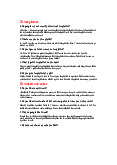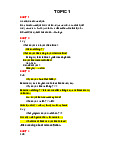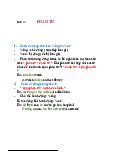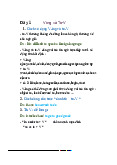


Preview text:
1. __________ is the amount a business earns after deducting what it spends for salaries and
other expenses. A. Profit B. Revenue C. Interest D. Dividends
2. The amount of goods and services people can buy with the money they have is called their: A. nominal income. B. consumer price index. C. profit margin. D. standard of living.
3. Honda and Toyota have used insourcing for years to produce cars in the United States. Insourcing:
A. helps offset the number of jobs being outsourced.
B. increases the number of jobs being outsourced.
C. damages the United States economy.
D. causes jobs to be lost to overseas competitors.
4. Entrepreneurs weigh the differences between the benefits of starting a business and those
things that they are likely to forego because they choose to work for themselves. Such things
they are likely to pass-up on are:
A. the freedom to make their own decisions.
B. local government benefits such as enterprise zone tax credits.
C. employer paid benefits such as paid vacation and health insurance.
D. tickets to sporting events that trading partners may provide. 5. Resource development is:
A. the study of how society chooses to employ resources to produce goods and services and
distribute them for consumption among various competing groups and individuals.
B. the study of how to increase the amount of available resources and create conditions that will
make better use of these resources.
C. the part of economics that looks at the operation of a nation's economy as a whole.
D. the part of economics that looks at particular markets.
6. Which of the following statements would a follower of Adam Smith most likely make?
A. The federal government should use its ability to spend and tax to guide the decisions of businesses and consumers.
B. Market economies are flawed because they put too much emphasis on economic growth and
not enough on environmental problems.
C. Overpopulation is the main danger confronting modern economies.
D. If people are given the freedom to follow their own interests, theoretically their efforts will
lead to economic growth that benefits society as a whole.
7. _________ is the name of a free-market economic system in which most of the factors of
production and distribution - such as land, factories, railroads, and stores - are owned by individuals. A. Socialism B. Capitalism C. Communism D. Marginalism
8. Which of the following statements about capitalism is the most accurate? A.
In capitalist economies, most resources are owned by the government.
B. A strength of capitalism is its ability to deal with environmental problems.
C. Capitalism is characterized by unequal distribution of wealth and income.
D. A drawback of capitalism is that people have little freedom to pursue their own goals.
9. A nation has a ___________ in the production of a good or service if it can produce that good
or service more effectively or efficiently than it can produce other goods. A. supreme advantage B. primary efficiency C. qualified advantage D. comparative advantage
10. Free trade between nations generally results in:
A. industrialized nations gaining at the expense of developing nations.
B. an increase of jobs in developed nations.
C. mutually beneficial exchange relationships.
D. higher prices for imported goods.
11. The __________ is the difference between money flowing into a country from exports, and
money leaving the country for imports, plus money flows coming from other factors such as
tourism, foreign aid, military expenditures, and foreign investment. A. balance of payments
B. balance of trade surplus
C. balance of cash flows D. balance of trade
12. A benefit of contracting with export trading companies is:
A. They are the experts in establishing trading partners abroad, and negotiating all the details in retaining customers.
B. They are experts in staying out of the financial transactions of establishing new markets.
C. They will always assume the risk if your product does not sell to the foreign customer.
D. They keep you legal because they serve as the franchisor and make certain that your products meet ISO requirements.
13. Obeying the law is ________ ethical behavior. A. essentially the same as B. the first step toward C. the opposite of D. unlikely to lead to
14. Ethical behavior covers a ________ range of conduct than legal behavior. A. wider B. more limited C. smaller D. less demanding
15. Relationships between businesses and among nations:
A. should be based on international law, exclusively.
B. should be based on fairness, honesty, openness, and moral integrity.
C. should be scrutinized carefully to make some determination as to whether both sides have the
same type of leader behavior when it comes to assigning work.
D. will be adversarial because seldom does either side believe in win-win situations.
16. Companies are using _____________ to communicate their corporate social responsibility actions to their customers. A. sales promotion
B. traditional advertising on television and radio C. social media
D. their employees, word of mouth
17. The __________ is the most common form of business ownership. A. partnership B. corporation C. joint venture D. sole proprietorship
18. A partner (owner) who invests money in a business does not take an active role in managing
the operation, and is only subject to losing the funds he/she invested. A. implied partner. B. limited partner. C. partial partner. D. corporate partner.
19. When comparing general partnerships to sole proprietorships, an advantage of partnerships is that they:
A. are less risky, because each partner is responsible for only a specified fraction of the firm's debts. B. are easier to terminate. C. cost less to organize.
D. give the firm a stronger financial foundation.
20. Emily wants to open a chain of hair styling salons and hopes to attract investors to help
finance growth. She considered forming a C corporation, but wants to have more
flexibility about how the new business will be taxed. She also wants to offer
investors/owners limited liability. Emily can satisfy her objectives by setting up a(n): A. limited liability company. B. S corporation. C. alien corporation. D. general partnership.




